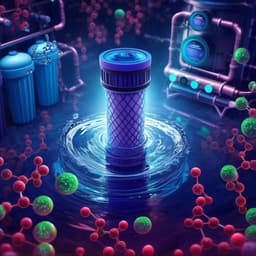
Environmental Studies and Forestry
Insights to estimate exposure to regulated and non-regulated disinfection by-products in drinking water
P. E. Redondo-hasselerharm, D. Cserbik, et al.
This study conducted by Paula E. Redondo-Hasselerharm and colleagues uncovers significant human exposure to disinfection by-products in drinking water. Through thorough analysis of tap, bottled, and filtered water, as well as urine samples, the research reveals high levels of DBPs in tap water and a notable link between urine concentrations and drinking habits. Explore these groundbreaking insights into public health risks associated with water consumption.
~3 min • Beginner • English
Introduction
Chemical disinfection of drinking water prevents infections but forms complex mixtures of disinfection by-products (DBPs), whose composition depends on source water and treatment. Over 600 DBPs are known, with long-term exposure associated with bladder cancer and potential reproductive effects. Most evidence and regulation focus on a limited set of DBPs (e.g., THMs and, increasingly, HAAs, chlorite, and chlorate in the EU). Regulated DBPs represent only a small fraction of total halogenated DBPs and may not drive toxicity. Epidemiological studies often use THMs as markers, though they may not be causal. Among nonvolatile HAAs, urinary TCAA has shown promise as a biomarker. There is limited monitoring of emerging/non-regulated DBPs and a lack of models to predict them for exposure assessment. The study aims to provide insights for estimating exposure to a wide range of DBPs in Barcelona by characterizing occurrence in tap and bottled water, developing predictive models for non-regulated DBPs using routinely monitored parameters, assessing the effect of domestic filters, and exploring urinary HAAs as exposure biomarkers.
Literature Review
Prior work has predominantly evaluated THMs and, to a lesser extent, HAAs, with THMs commonly used as DBP exposure markers despite uncertainty about causality. EU regulations historically covered total THMs and bromate, with new requirements to include HAAs, chlorite, and chlorate. TCAA in urine has been used as a proxy biomarker, with reported correlations between ingested and urinary TCAA. Predictive models have been developed mainly for THMs using water quality parameters, while prediction of non-regulated DBPs in finished water for exposure assessment has not been explored. Bromide levels influence formation toward brominated species, which are often more cytotoxic/genotoxic than chlorinated analogues.
Methodology
Design and setting: Cross-sectional sampling in Barcelona, Spain (city and metropolitan area), primarily supplied by surface waters (Llobregat and Ter rivers), with higher bromide in Llobregat influencing brominated DBP formation. Participants: 39 volunteers recruited to represent 42 postal codes (3 locations sampled from public fountains). Data collected August 31–October 16, 2020. Questionnaire collected sociodemographics, water consumption (tap, filtered, bottled at home and outside), and lifestyle factors. Sample collection: - Tap water: unfiltered samples at 42 locations; filtered tap water in 11 homes (N=6 activated carbon pitcher, N=5 reverse osmosis). Collected in four containers for different analyte groups; ascorbic acid used as quencher for organic DBPs; cold water flushed ~2 min prior; samples kept cold and transported to labs within 1–4 days. - Bottled water: 10 popular natural mineral water brands (1.5 L PET) purchased locally. - Urine: first morning-void spot samples from 39 volunteers collected same day as home water sampling; stored at −20 °C until analysis. Laboratory analyses: - Water analytes: 11 HAAs, 4 THMs (TCM, BDCM, DBCM, TBM), 4 HANs (DCAN, BCAN, DBAN, TCAN), 2 haloketones (TCP, DCP), trichloronitromethane (TCNM), chlorate, chlorite. - Instruments/methods: HAAs, chlorate, chlorite by LC-MS/MS (online SPE for HAAs) per Planas et al. with modifications. THMs, HANs, HKs, TCNM by liquid–liquid salted microextraction and GC-MS/MS. Urine: 11 HAAs by offline SPE and LC-MS/MS; creatinine by automated alkaline picrate method; HAAs results adjusted by creatinine (µg/g). - LOQs (water): 0.1 µg/L (THMs, HANs, HKs, TCNM) to 10 µg/L (chlorate, chlorite). LODs (urine HAAs): 0.02 µg/L (TCAA) to 3.98 µg/L (iodoacetic acid). Quality control followed 2002/657/EC. Statistical analyses: - Descriptive statistics for >LOQ values. Calculated bromine incorporation factors (BIF) for THMs and HAAs; normalized BIFs computed. Spearman correlations among DBPs and between ingested TCAA and urinary TCAA; PCA to explore DBP grouping. Values <LOQ assigned LOQ/2 for correlations/PCA. - Predictive modeling: Linear regression models with individual THMs (TCM, BDCM, DBCM, TBM) as predictors (conductivity excluded due to collinearity). Tested variable transformations (none, log, sqrt, squared) and combinations (4 simple, 11 multiple). Selected best based on cross-validated R², 95% CI, RMSE, and VIF<10; fivefold cross-validation used. - Super learner (SL) machine learning: fivefold cross-validated ensemble using libraries of algorithms (GLM, Bayesian GLM, Random Forest variants, MARS, local polynomial regression, neural networks, adaptive splines), with predictors including 4 THMs, conductivity, pH, and geocodes. Compared SL vs linear models on R², CI, RMSE. - Filter effects: Paired t-tests (with normality checks and transformations as needed) comparing concentrations before/after filtration; average percent change calculated. - Estimated ingestion: Computed by multiplying residential water type–specific DBP concentrations by reported volumes consumed (L/day). Ethical approval from Parc de Salut Mar Ethics committee; informed consent obtained.
Key Findings
- Occurrence in tap water (N=42): THMs and HANs detected in 100% of samples; HAAs in 98%; chlorate in 98%; chlorite in 62%; TCP in 36%. Six analytes were <LOQ in all samples (MCAA, MIAA, DIAA, TCAN, DCP, TCNM). Median concentrations (µg/L): total THMs 42; total HAAs 18; total HANs 3.2; TCP 1.2; chlorite 53.9; chlorate 214. - Bromination patterns: Median BIF values: THMs 2.48, dihalogenated HAAs 1.78, trihalogenated HAAs 0.08 (normalized medians 0.83, 0.89, 0.03), indicating predominance of brominated species. - Correlations/PCA: PCA revealed two components: (1) chlorinated species cluster (plus TBM) explaining 61.5% of variance; (2) brominated species cluster and chlorate explaining 16.3%. THMs correlated variably with HAAs and HANs; chlorate showed weak correlations except moderate with chlorite (ρ=0.58). - Bottled water (N=10): Only chlorate detected in 3/10 samples (median 13.0 µg/L; IQR 12.4–22.4 µg/L); other DBPs not analyzed or below detection. - Predictive models (fivefold CV): Linear regression generally matched or outperformed SL. Good predictive ability (cross-validated R² ~0.8–0.97) for several non-regulated DBPs using THMs as predictors: DCAA (R²=0.89; predictor TCM), TCAA (R²=0.97; TCM), BDCAA (R²=0.82; DBCM, TBM, sqrt), DCAN (R²=0.97; BDCM, DBCM, sqrt), BCAN (R²=0.76; BDCM, DBCM, sqrt), DBAN (LM R²=0.89; SL R²=0.92; all THMs, log), total HANs (R²=0.65), TCP (R²=0.82; all THMs, log), chlorite (R²=0.77; DBCM, TBM, sqrt), total HAAs (R²=0.85; all THMs, log), chlorinated HAAs (R²=0.96; TCM, log). Poorer fits for MBAA, DBAA, TBAA, BCAA, DBCAA, and chlorate (R²<0.7). - Domestic filters: Activated carbon (pitcher) reduced DBP concentrations by 27–80% depending on class (e.g., total THMs −80%, total HANs −75%, total HAAs −52%, chlorite −60%, TCP −63%, chlorate −27%). Reverse osmosis reduced DBPs by ~98–100% across classes; post-RO residuals near/below LOQ. - Urinary biomarkers (N=39): TCAA most frequently detected (69.2% >LOD). Creatinine-adjusted urinary TCAA: mean 3.0 µg/g (median 1.3 µg/g; range <0.01–16.0). Moderate positive correlation between creatinine-adjusted urinary TCAA and estimated TCAA ingestion at home (r≈0.48; p≈0.002; R²≈0.48), indicating ingestion explains about half of urinary variability. Other urinary HAAs with detections included DBCAA (23.1%), BDCAA (20.5%), DCAA (10.3%), MCAA (2.6%).
Discussion
The study addressed the need for improved exposure assessment for non-regulated DBPs by characterizing multiple DBP classes in a bromide-influenced Mediterranean drinking water system and by developing predictive models based on routinely monitored THMs. Findings confirm widespread occurrence of both chlorinated and brominated DBPs, with brominated species predominating—relevant given their higher reported cytotoxicity/genotoxicity. The moderate to strong correlations between specific THMs and several DBPs underpin the successful prediction of certain non-regulated DBPs with simple linear models using THM species as predictors, demonstrating a pragmatic approach for epidemiological exposure reconstruction where routine monitoring data are limited to THMs. Conversely, chlorate exhibited weak correlations and poor predictability, reflecting distinct formation/removal pathways. Point-of-use treatment assessments showed that activated carbon can substantially reduce DBPs under real-world conditions, though performance likely depends on filter maintenance, while reverse osmosis consistently achieved near-complete removal, albeit with potential trade-offs (e.g., mineral removal). The biomonitoring component supports urinary TCAA as a practical, though partial, indicator of ingestion exposure from home drinking water, with moderate correlation reflecting contributions from other exposure sources/routes, individual behavior, and temporal mismatch. Collectively, results advance exposure assessment strategies for epidemiological studies and highlight which DBPs are amenable to prediction from routine data and which require direct measurement.
Conclusion
This study provides an integrated assessment of DBP occurrence in tap and bottled water and explores urinary HAAs as biomarkers in Barcelona. It demonstrates that concentrations of several non-regulated DBPs can be predicted with good accuracy using linear models based on routinely monitored THMs, facilitating exposure assessment in settings lacking comprehensive DBP monitoring. Domestic activated carbon and reverse osmosis filters effectively reduce DBP levels, with RO achieving near-total removal. Urinary TCAA correlates moderately with estimated ingestion from home water, supporting its use as a complementary biomarker. Future work should validate predictive models with larger datasets and across diverse water systems, refine biomarker approaches (including additional HAAs), and evaluate site-specific determinants of DBP formation and removal.
Limitations
- Small sample size (N=42 water sites; N=39 participants) limits model robustness and external generalizability; models require validation in larger, diverse datasets. - Potential selection bias from social media recruitment; sample may not represent the general adult population. - Self-reported water consumption may introduce measurement error; only residential ingestion considered, not total personal exposure across settings. - Spot urine samples collected cross-sectionally with water sampling may not capture longer-term exposure; temporal mismatch may attenuate correlations. - Domestic activated carbon filters assessed under real-life conditions likely with variable maintenance, affecting performance. - Some urinary HAAs exhibited matrix effects/instability (e.g., BCAA, TBAA not reported), limiting biomarker interpretation. - Chlorate poorly predicted from THMs due to differing formation/removal pathways; indicates need for direct measurement for certain DBPs. - Site-specific water characteristics (e.g., bromide levels) may limit transferability of models to other regions.
Related Publications
Explore these studies to deepen your understanding of the subject.







